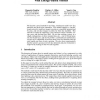135
Voted
CLOR
2006
15 years 2 months ago
2006
We present a method for object categorization in real-world scenes. Following a common consensus in the field, we do not assume that a figure-ground segmentation is available prior...
CLOR
2006
15 years 4 months ago
2006
We present a new class of statistical models for part-based object recognition. These models are explicitly parametrized according to the degree of spatial structure that they can ...
130
click to vote
CLOR
2006
15 years 4 months ago
2006
We present a "parts and structure" model for object category recognition that can be learnt efficiently and in a weakly-supervised manner: the model is learnt from examp...
112
Voted
CLOR
2006
15 years 4 months ago
2006
Many approaches to object recognition are founded on probability theory, and can be broadly characterized as either generative or discriminative according to whether or not the dis...
105
Voted
CLOR
2006
15 years 4 months ago
2006
The chapter describes visual classification by a hierarchy of semantic fragments. In fragment-based classification, objects within a class are represented by common sub-structures ...
134
Voted
CLOR
2006
15 years 4 months ago
2006
Abstract. A popular framework for the interpretation of image sequences is the layers or sprite model, see e.g. [1], [2]. Jojic and Frey [3] provide a generative probabilistic mode...
139
click to vote
CLOR
2006
15 years 4 months ago
2006
We describe an approach to object retrieval which searches for and localizes all the occurrences of an object in a video, given a query image of the object. The object is represent...
131
Voted
CLOR
2006
15 years 4 months ago
2006
This chapter proposes a representation of rigid three-dimensional (3D) objects in terms of local affine-invariant descriptors of their images and the spatial relationships between ...
111
Voted
CLOR
2006
15 years 4 months ago
2006
We describe a novel method for real-time, simultaneous multi-view face detection and facial pose estimation. The method employs a convolutional network to map face images to point...
108
Voted
CLOR
2006
15 years 4 months ago
2006
Recent advances in object recognition have emphasized the integration of intensity-derived features such as affine patches with associated geometric constraints leading to impressi...




